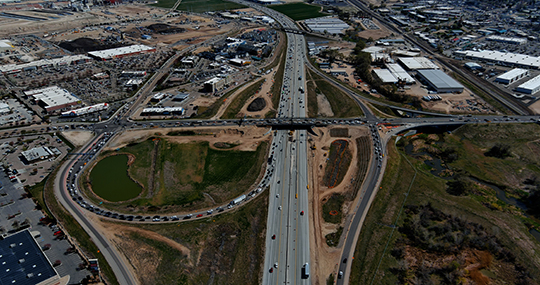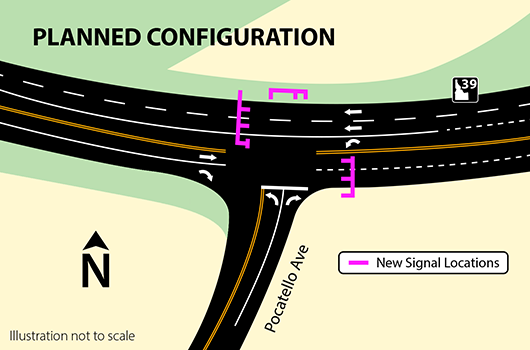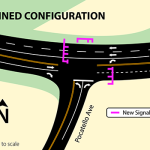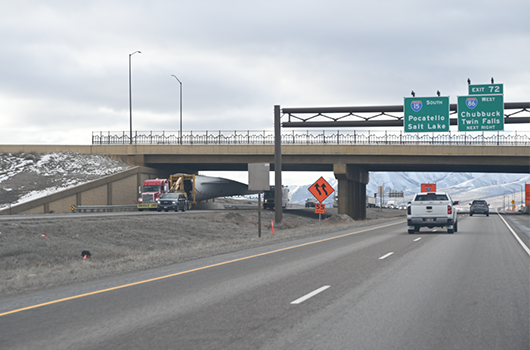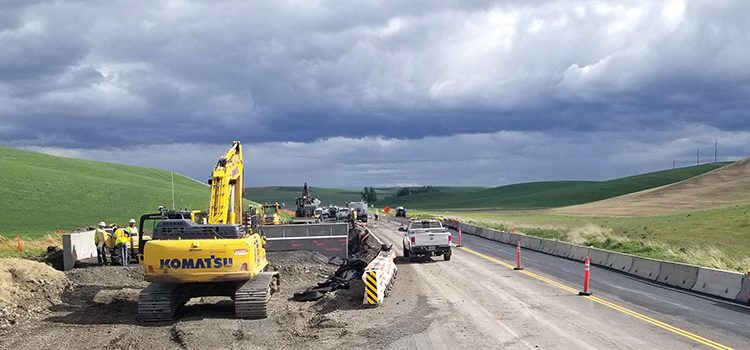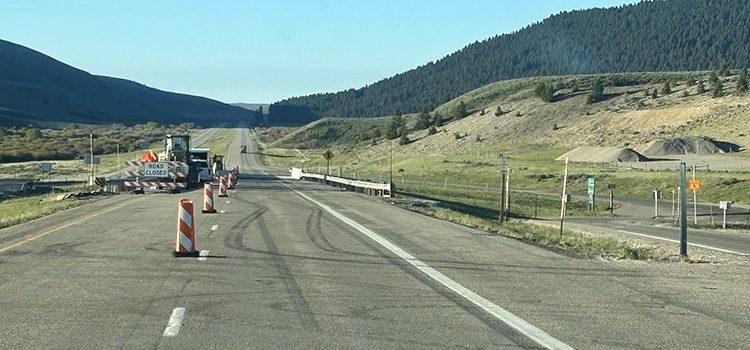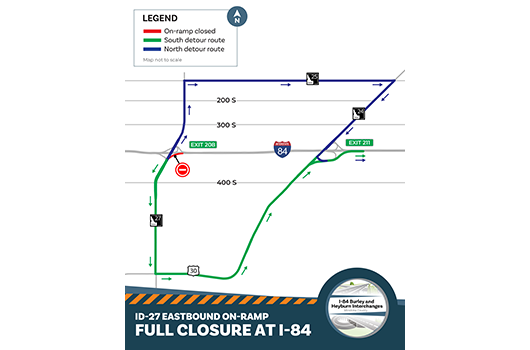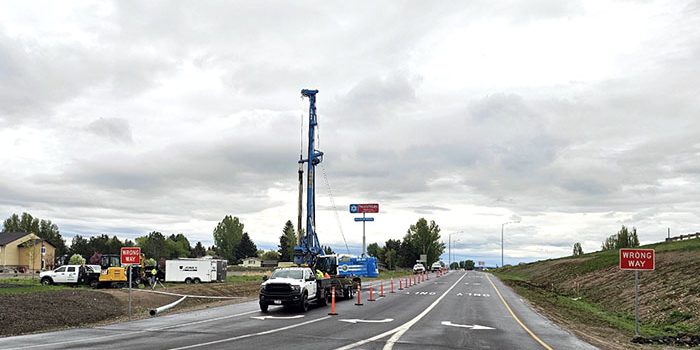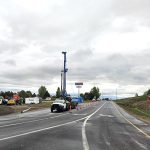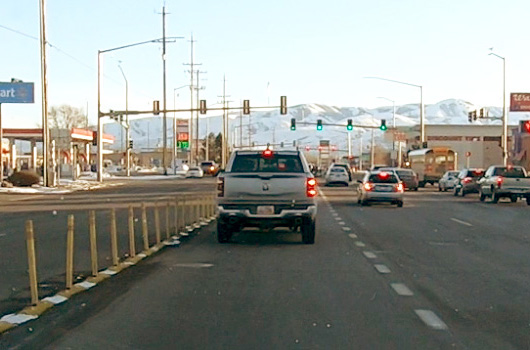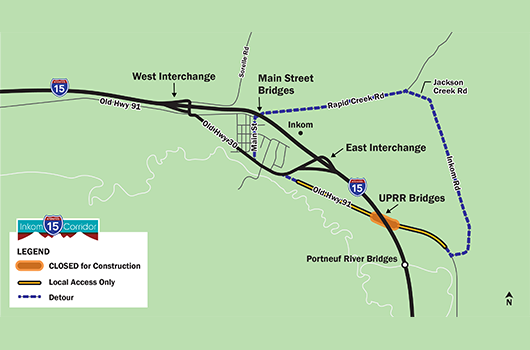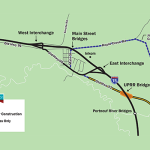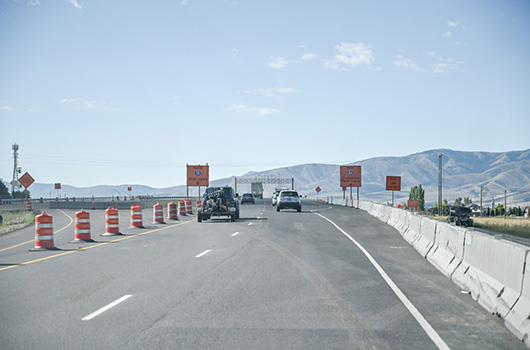The Idaho Transportation Department will close I-84 under the Karcher Interchange Tuesday and Wednesday nights to place girders on the overpass bridge. Detours will be in place.
Closures will run from 10 p.m. to 5 a.m. each night. On Tuesday night, westbound traffic will be affected, and on Wednesday night, eastbound traffic will be affected.
Motorists traveling westbound on I-84 Tuesday night will:
- Exit I-84 at the Northside Interchange (Exit 35).
- Travel north on Northside Blvd.
- Turn left on to Karcher Road.
- Travel west until you reaching the Karcher Interchange westbound on-ramp.
- Use the Karcher Interchange westbound on-ramp to merge back on to westbound I-84.
Motorists traveling eastbound on I-84 Wednesday night will:
- Exit I-84 using the Karcher Interchange eastbound off-ramp (Exit 33).
- Cross Karcher Road.
- Use the eastbound on-ramp to merge back onto I-84.
View the detour maps at ITDProjects.idaho.gov/pages/Karcher IC Maps
The girders were fabricated locally and will support the new westbound lane on Karcher Road over the interstate. ITD will host a Facebook live event during the girder placement on Tuesday, June 10. To tune in visit the ITD Facebook page.
Improvements on this project include:
- Adding a free running right hand turn at the westbound off-ramp
- Paving a third westbound lane on Karcher Road from the westbound off-ramp to Sundance Road
- Reinforcing the Karcher Interchange and Indian Creek bridges to support the new lane
- Updating signal equipment and adding a pedestrian flashing beacon at the eastbound on-ramp
- Building a separated mixed-use path on the north side of Karcher Road
These improvements will increase safety and traffic flow at the interchange. Construction is expected to finish in fall 2025.
Stay informed by signing up for email and text alerts regarding project updates. Text 84CORRIDOR to 1-866-483-8422 or visit itdprojects.idaho.gov/pages/karcheric. For questions, contact the project team at (208) 334-8002. Maps and other details can also be found on the project website.
The Idaho Transportation Department will begin construction Monday at the intersection of Pocatello Avenue and State Highway 39 in American Falls. The $3.5 million project will redesign the busy intersection to improve safety.
Work will place a signal at the intersection Pocatello Avenue and SH-39. SH-39 will also be widened to four lanes from the intersection to Fairgrounds Road. New turn lanes will also be built on SH-39 for traffic heading to Pocatello Avenue.
This year construction will take place through August and will focus on realigning and widening the intersection. All lanes will remain open, but traffic will be slowed in the construction zone. Flaggers will be present during different phases of the project. Access to the American Falls Airport and the Power County Fairgrounds will remain open throughout construction.
In the spring of 2026 ITD will return to install the traffic signal. Project details are available on ITD’s projects website at itdprojects.idaho.gov/pages/pocatelloave-i86b.
The Idaho Transportation Department will move Interstate 15 traffic Tuesday and Wednesday nights to accommodate girder placement at 2.5 Mile Road Bridge.
Traffic will be reduced to a single lane in each direction and shifted onto the same side of the interstate. Work will be conducted between 7 p.m. and 5 a.m. each night with a speed limit of 55 miles per hour through the work zone.
Motorists should carefully follow signs and posted speed limits while traveling through the construction area. With crews working day and night on the project to make I-15 three lanes from Northgate to Fort Hall it is especially important that drivers be alert and travel safely.
I-15 serves as a major transportation corridor through eastern Idaho. These improvements will increase capacity and improve safety to serve the region’s growing transportation needs for years to come.
Motorists are encouraged to use 511.idaho.gov or the 511 app to keep track of project detours. Project details are available on ITD’s projects website at itdprojects.idaho.gov/pages/i15northgatetoblackfoot.
Daytime intermittent closures on U.S. Highway 95 between Moscow and Lewiston near Thorn Creek/ Uniontown Cutoff will be in effect next Wednesday and Thursday, May 28 and 29, from 6 a.m. to 6 p.m. while the Idaho Transportation Department is installing new bridge girders at the Thorn Creek Bridge.
The bridge will fully close to both north and southbound traffic while each girder is installed. Girders are the large horizontal beams that will support the new bridge deck being constructed this summer.
Flaggers will be present to allow traffic to pass one direction at a time between each girder installation. Motorists are encouraged to seek an alternative route to avoid delays.
This work at Thorn Creek Bridge is part of a large-scale project improving safety along US-95 from Lewiston to Moscow. Portions of this project are funded as part of Idaho Governor Brad Little’s Leading Idaho transportation funding initiative. These funds are used to make investments in critical state infrastructure to enhance safety, mobility and to sustain Idaho’s strong economy into the future.
Digital message boards are currently in place to alert drivers of these closures next week. Updates can also be found on the Idaho 511 app and at https://511.idaho.gov/.
Southbound traffic is now able to travel over the Stoddard Creek Bridge at Interstate 15 Exit 184 just in time for the Memorial Day weekend. Travelers can now turn both right and left onto Stoddard Creek Road underneath the bridge. This road provides access to multiple camping and recreational opportunities in the area.
Southbound 1-15 traffic is no longer diverted onto the Exit 184 ramps, but back onto one lane over the Stoddard Creek Bridge along the main roadway. This one lane closure allows the Idaho Transportation Department and contractor partners to accomplish finishing work, like replacing guardrails, on the passing lane of I-15. Work is expected to be complete and all traffic restrictions removed within the next month.
This update can be seen on the Idaho 511 app and at https://511.idaho.gov/.
The on-ramp to head east on Interstate 84 at the Burley Interchange will close for the week starting Monday morning for repaving.
The closure will be in place from 6 a.m. Monday (May 19) to 11 p.m. Friday (May 23). To head east on the freeway, drivers will be detoured to the nearest on-ramp about five miles to the east at the Heyburn Interchange (Exit 211).
Drivers will still be able to head west on I-84 from the Burley Interchange. Traffic on I-84 remains two lanes in each direction, and the speed limit is reduced to 65 miles per hour in the work zone.
Construction has been underway since 2024 to update the Burley and Heyburn Interchanges to meet growing traffic demands and is funded as part of Idaho Governor Little’s Leading Idaho transportation funding initiative. The Leading Idaho initiative allows ITD to take a deliberate approach to advance large projects that will enhance safety, improve mobility, further strengthen Idaho’s economy, and positively impact the Magic Valley and communities across the state for years to come.
To learn more about the project, please visit itdprojects.idaho.gov/projects/i-84-burley-and-heyburninterchanges. This closure and others will be posted to 511.idaho.gov.
REXBURG— One lane and full closures at Exits 332 and 333 off U.S. Highway 20 in Rexburg are ongoing today and into next week. These restrictions are required so contractors can drill deep foundations for the large overhead signs that will soon be the finishing touch on the Diverging Diamond Interchanges completed last fall.
Both of these Rexburg exits will see one lane closures in the areas where drilling work is occurring. Traffic control will move with equipment and the road fully open wherever possible.
Next Monday, May 19 and Tuesday, May 20 Exit 333 will be fully closed overnight from 7 p.m. to 7 a.m. ITD and contractor partners are working through the night so traffic can flow as usual through the daytime hours.
Large equipment, including a drill rig to reach the required 18-foot foundation depth, will need to be in the roadway underneath US-20 for work at both locations, reaching across and over the median concrete barriers. To keep everyone safe and be able to swiftly clean up any water or debris that the drilling creates, lane restrictions and closures have been deemed essential. ITD and contractor partners are committed to completing the work as quickly as possible to cause the least amount of traffic disruption.
“The foundation for the bridge and cantilever posts that will hold the large overhead signs has to be particularly deep,” Resident Engineer Curtis Calderwood stated. “We want them to be secure and have integrity in the wind. This is pretty well the last holdout for getting the exits truly finished.”
These restrictions and closures will be noted on the Idaho 511 app and at 511.idaho.gov.
The Idaho Transportation Department and its construction partner Wadsworth Brothers Construction is beginning reconstruction of Interstate 15 at Inkom.
Work will replace I-15 bridges in three locations:
- Over the Union Pacific Railroad (UPRR) tracks and Old Highway 91.
- Over Rapid Creek Road (Main Street).
- I-15 bridges and reconstructing the West Interchange.
ITD combined and streamlined the projects to reduce the construction timeline to approximately two years rather than doing one location at a time over three years. This approach minimizes disruption to the local community and the traveling public and efficiently uses construction funds.
Old Highway 91 will be closed under I-15 beginning Monday, weather and other factors permitting, to allow Idaho Power to relocate utilities. Local access will be allowed. Other drivers will be detoured along Rapid Creek Road (Main Street). The detour will remain in place until mid-June.
I-15 traffic will be reduced to one lane in each direction from early March until late October.
For project progress and to sign up for construction updates, go to the project webpage at itdprojects.idaho.gov/pages/i15-inkom-corridor. Motorists are encouraged to use 511.idaho.gov or the 511 app to keep track of project detours.
The Idaho Transportation Department’s $112 million rebuild of the System Interchange for Interstate 86 and Interstate 15 at Pocatello is entering its final year of construction with crews working in multiple areas throughout the worksite.
Five bridges were built in the last year, bringing the project total up to eight new structures. Two of the new bridges are steel and measure 414 feet long each. The other three bridges are concrete and measure a total of 387 feet in length. The construction of these bridges included 725 feet of 8-foot diameter concrete shafts installed underground for bridge foundations. In addition, 10,000 feet of steel piles were also driven underground for bridge foundations.
The massive project registered other impressive statistics in 2024:
- 247,319 cubic yards of dirt moved.
- 143,500 tons of structural dirt imported.
- 4,000 cubic yards of concrete poured.
- 55,894 tons of asphalt placed.
- 568,862 pounds of metal reinforcement installed.
In the coming year several items will be completed to button up the project.
- The new southbound-to-westbound ramp will be completed.
- The old northbound-to-westbound ramp will be removed.
- The temporary southbound-to-westbound ramp will be removed.
- The roadway north of the Pocatello Creek on-ramp will be built to its final grade. This will allow movement from Pocatello Creek to Chubbuck and remove the detour currently in place.
- The new Chubbuck Road underpass roadway will be completed.
- A chip seal will be applied to extend the life of the new asphalt pavement installed by the project, and the road will be restriped to its final lane configuration.
- Bridge approaches will be smoothed out to remove bumps made during construction.
Construction is anticipated to be completed in August.
“We appreciate the community’s patience as ITD continues to work with the contractor to button up work items and complete the remaining tasks for this historic project,” Project Manager Greg Roberts said. “ITD is excited to see the travelling public use this updated system interchange for years to come.”
Originally built in the 1960s, the I-86 and I-15 System Interchange is undergoing a rebuild to improve safety and replace aging infrastructure.
Motorists should carefully follow signs and posted speed limits while traveling through the construction area. With crews working day and night at the System Interchange it is especially important that drivers be alert and travel safely.
Motorists are encouraged to use 511.idaho.gov or the 511 app to keep track of project detours. Project details are available on ITD’s projects website at itdprojects.idaho.gov/pages/i-86i-15-system-interchange.
